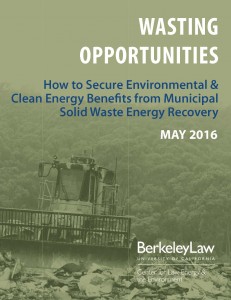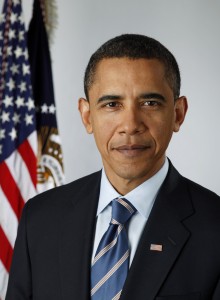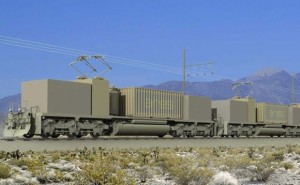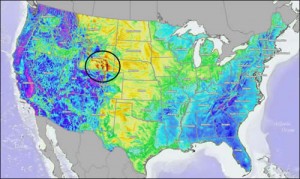As California and other states zoom toward getting 50% of their energy from renewable resources like solar and wind, there’s no question that we’ll need a bigger geographic grid footprint to balance these sources. We can’t rely solely on these in-state, intermittent resources without driving up rates and firing up backup fossil plants to compensate for their variable production.
An expanded grid addresses that problem (along with energy storage and demand response) and provides economic benefits to boot. It means, for example, that California can sell its excess surplus power in the spring and fall to other states, while we can import solar from Arizona in the morning or wind from Wyoming at other times.
That’s why California’s grid operator — the Independent System Operator (CAISO) — is so gung ho on purchasing the neighboring PacifiCorp, which operates in six western states. As Utility Dive reports, CAISO’s CEO is bullish about the opportunities, both to save ratepayers money and to clean the grid.
But the politics are messy. Here in California, as E&E reports [subscription required] the Sierra Club in particular is concerned that the merger of these two grid operators will give a bunch of coal plants in the PacifiCorp portfolio a new market to access and therefore a longer lease on life. NRDC counters that any bump in emissions will be short-term and that the merger will ultimately greatly reduce emissions.
Meanwhile, in the states subject to the merger, the opposition is not from environmental groups but from the in-state generators that risk being displaced by cheap out-of-state renewables. After all, it’s hard for them to compete with surplus solar power from California that is coming to the state for cheap, displacing coal and gas-fired power in the process. These states also fear a loss of control over the grid operators, as the governing boards are likely to be dominated by California appointees.
All in all, it’s a tough political situation but one that shouldn’t be insurmountable, with the right compromises — particularly given how much ratepayers can benefit from the merger and how crucial an expanded grid footprint is to deep decarbonization of the electricity supply.
Governor Brown’s proposal in his new budget to make certain housing developments eligible to be approved by the state “by right” has riled up not just local governments — who stand to lose discretionary approval over these projects — but some labor and environmental groups as well.
It’s pretty obvious why these groups are upset: the by-right state approval means they lose their leverage over projects under the California Environmental Quality Act (CEQA), which can trigger lengthy local environmental review for discretionary approvals. And the governor’s proposal, as currently written, lacks safeguards to ensure that only environmentally beneficial projects are eligible for state approval.
Yet local resistance to new housing is a problem well beyond CEQA, and its cumulative effect — through restrictive local zoning, discretionary rejection of new housing, and citizen petitions and lobbying — has created a massive housing shortage in the state’s big cities. The inevitable result is high housing costs squeezing middle-income earners, with displacement and gentrification pushing out low-income earners. It’s becoming a national drag on our economy, while pushing new development out to the exurbs and over open space and farmland.
So in principle, state approval of certain housing projects is justified. But it needs to be the right kind of housing development, consistent with existing local plans. A relatively straightforward condition on these projects to be eligible is that they are located within a half-mile of a major transit stop and meet certain vehicle miles traveled (VMT) and greenhouse gas emission profiles. That would ensure environmental performance and that the projects do not contribute to sprawl.
The basic formula would be: 1/2 mile + VMT + GHG = by-right approval.
Of course, you’d probably have to layer in an affordable housing requirement as well to achieve political consensus. But increasing supply today will go a long way to stabilizing prices and therefore minimizing displacement, as well as creating the housing stock that will one day be affordable to low-income earners. And in the meantime, we can ensure that these new projects contain affordable units.
And for the labor groups, these multi-unit housing developments typically require higher-paying, high-skilled jobs that pay better than sprawl construction.
It would be a win-win, if our political leaders and advocates can arrive at compromise.
Trump has made no secret of his rejection of climate science. Instead, he counter-punches by saying the real threat is global warming caused by a nuclear bomb (video above), as Politico reports:
The seemingly far-fetched threat of nuclear-induced climate change has been on Trump’s mind since at least June, when he warned of “nuclear warming” during a visit to The Chicago Tribune. His concern: The environmental impact of a potential nuclear blast gets far less attention than the greenhouse gas emissions that are already raising sea levels and temperatures worldwide.
What’s his solution? Trump’s underlying policy goal here is actually dismissing calls for federal action to cut U.S. emissions by raising the profile at a presidential level of both national security and nuclear containment. It’s a counter-argument as well to both Obama and Clinton, who have described climate change as a threat on par with terrorism.
It’s an odd way to deflect on the science and attempt instead to muddle the issue. But who knows — in this election year, it may actually work well enough to confuse people. And of course the other challenge for climate advocates is that climate change doesn’t rank high on the list of voter concerns.
It certainly doesn’t help when a major party nominee tosses out strange, deflecting rhetoric like this, but it’s a line of argument that advocates should be ready to refute.
A campaign to sue the oil giant for deceiving the public on climate change is gaining steam (no pun intended), as Politico reports:
Interviews with advocates on both sides of the feud reveal how quickly the anti-Exxon movement has sprouted, to the point that it’s now consuming op-ed pages, airwaves and courtrooms across the country. Once merely intent on shaming the oil giant into better behavior, environmentalists are pursuing a strategy to discredit the company, weaken it politically and perhaps make it pay the kinds of multibillion-dollar legal settlements that began hitting the tobacco industry in the 1990s.
The campaign — led by some of the same climate activists who defied Beltway wisdom by killing the Keystone XL oil pipeline — has mushroomed into far more than a greens-versus-Exxon feud.
Just last week, a leaked subpoena from the attorney general in the U.S. Virgin Islands revealed a vast probe that demanded Exxon’s communications with more than 100 free-market think tanks, conservative consulting firms and climate-skeptic scientists — proof, the company’s supporters say, that environmentalists are using the legal system to launch a broad attack on their political opponents. The subpoena targets Exxon’s dealings with parties including the Competitive Enterprise Institute, the U.S. Chamber of Commerce Foundation, the Hoover Institution, George Mason University and scientists at the Massachusetts Institute of Technology, the University of Alabama and the University of Delaware.
Perhaps that’s why the company is now investing in some pretty interesting clean technologies, including one that could help our zero-emission transportation future, as Green Car Reports describes:
ExxonMobil is backing a new process that would capture carbon dioxide from power plants, and use it to feed fuel cells.
The oil giant announced Thursday that it is expanding a partnership with Connecticut-based FuelCell Energy to develop the smaller company’s fuel-cell technology.
FuelCell hopes to combine carbon capture and sequestration (CCS), which captures carbon-dioxide emissions from power plants, with carbonate fuel cells.
So maybe in the end, the climate punishment will be that ExxonMobil transitions to technologies that boost zero emission vehicles. While it shouldn’t be the only remedy for this kind of corporate malfeasance, assuming they lose in court, it would be a just one.
There’s been a low-grade battle for the future of zero-emission vehicles in California. On one side are the well-known battery electric models, with companies like Tesla capturing the global imagination and state residents buying hundreds of thousands of vehicles to date.
On the other side are hydrogen fuel cell vehicles, capturing the imagination of…well, maybe a hundred buyers and a few state officials.
The problem is that the state is spending millions of dollars to subsidize both technologies, when many experts feel that hydrogen fuel cell vehicles will have very little role in the state’s transportation future.
Now Fred Lambert at Electrek observes that even the fuel-cell automakers are changing their tune:
I think we are witnessing the start of a new (but long overdue) trend this year. The few established automakers still pushing fuel cell hydrogen vehicles appear to be warming up to battery-powered electric vehicles instead. Honda, Toyota and Hyundai, arguably the automakers most stuck on hydrogen, all announced new electric vehicle programs in the past few weeks.
Toyota is working on a plug-in version of the Corolla. Hyundai is bringing its Ioniq electric platform to market by the end of the year and this morning, we reported on the Korea-based automaker developing a next generation battery-powered electric SUV.
Those two automakers are arguably the most entrenched in fuel cell technology with the Toyota Mirai, the Hyundai Tuscon Fuel Cell, and billions spent in investments between the two of them, but the most telling news is that Honda, another fuel cell believer, is planning to launch a battery-powered version of the Clarity, a car it actually developed for its fuel cell program.
Lambert notes the gaping inefficiencies of fuel-cell vehicles compared to battery electrics (which are almost three times more efficient, when accounting for the energy in versus the energy out), plus the greater complexity of the manufacturing/fuel supply process with fuel cells.
The only advantage hydrogen offers over battery electrics is refueling time. But as batteries eventually move to up to the 600-mile range in the coming decades, and as fast-charging technology improves, this benefit will diminish. Meanwhile, battery electrics have the contrary advantage of being able to fuel in your home and anywhere with an outlet, versus the need for the gas station model of hydrogen fueling.
To my mind, the only true benefit of hydrogen is for long-haul trucking (although biodiesel and other biofuels may be just as well-suited), and possibly as a form of energy storage, assuming the hydrogen is made from surplus renewables.
But I’m skeptical that automakers will truly abandon their fuel cell plans so quickly. My guess is it will be another five years or more before they truly get the message from the market.
Leave it to a late-night comedian to set Sarah Palin straight on climate science:
The best line? “There’s no debate about the greenhouse effect, just like there’s no debate about gravity. If someone throws a piano off the roof, I don’t care what Sarah Palin tells you — get out of the way, it’s coming down on your head.”
And then he has a great takedown on the inevitable social media attacks he received after the original segment aired:
Nice to see pop culture taking on the naysayers. At this point, there’s probably not much more we can offer other than ridicule.
Every year, Californians send about 30 million tons of trash to landfills. While the state’s residents do their part to reduce, reuse and recycle, that’s still a whole lot of garbage. It’s not only a land use issue, it’s a climate change issue: as landfill waste decays, it emits methane, a powerful greenhouse gas.
 Many other countries and states are using energy recovery technologies to turn that trash into power. Mostly it’s done by heating and gasifying the material, now using more advanced and cleaner technologies to recover energy from this solid waste. California has three such facilities in operation. But since the 1980s we’ve essentially not allowed any new ones to be built, out of concern for local pollution impacts, particularly on low-income communities of color.
Many other countries and states are using energy recovery technologies to turn that trash into power. Mostly it’s done by heating and gasifying the material, now using more advanced and cleaner technologies to recover energy from this solid waste. California has three such facilities in operation. But since the 1980s we’ve essentially not allowed any new ones to be built, out of concern for local pollution impacts, particularly on low-income communities of color.
But as the energy recovery technology improves and the state grapples with its needs both to reduce greenhouse gas emissions and find non-fossil fuel-based sources of energy, waste-to-energy has emerged as an important issue in the Capitol recently.
To that end, Berkeley Law’s Center for Law, Energy and the Environment (CLEE) convened a group of environmental advocates, waste-to-energy technology developers, and state and local officials to discuss prospects for moving forward on this issue.
The concerns are significant: will the technologies adversely impact nearby communities, many of which may be disproportionately low-income and of color? Will energy recovery incentives discourage recycling? How reliable are these new technologies in reducing local emissions?
Based on that discussion, CLEE is today releasing the report Wasted Opportunities: How to Secure Environmental & Clean Energy Benefits From Municipal Solid Waste Energy Recovery, which I co-authored with Daniel Gergely Szabo. It recommends solutions for the state to address this challenge, including:
- The development of technology-neutral, performance-based standards for energy recovery of waste materials that will not discourage recycling;
- A revised waste disposal hierarchy that includes energy conversion that reduces overall pollution and contemplates “dispersion” as the lowest rung beyond disposal; and
- A revised landfill tipping fee that accounts for the full range of environmental costs.
Ultimately, should decision-makers identify appropriate technologies to deploy, the state will need a discussion on land-use siting to ensure that environmental justice concerns are addressed. While that process is not the subject of this report, it would be a worthwhile second step in contemplating these technologies.
You can read more on the report page here. In addition, I will be hosting a radio show discussion on this topic tonight at 7pm on San Francisco’s KALW radio 91.7 FM, a local NPR affiliate, for the show City Visions. My guests include:
- Jack Macy, Senior Commercial Zero Waste Coordinator for the City and County of San Francisco Department of the Environment;
- Rob White, Chief Strategist at Sierra Energy, a waste gasification and renewable energy company founded in Davis, California in 2004; and
- Heather Youngs, Senior Analysis Fellow at the Energy Biosciences Institute at the University of California, Berkeley and an adjunct professor of biochemistry at Michigan Technological University.
For those not in the area, you can tune in via the website, either live or afterwards when the audio is posted.
 In a long and fascinating piece on President Obama’s views on foreign policy, The Atlantic’s Jeffrey Goldberg relays the president’s thinking on a range of global issues, gleaned from multiple and extended interviews.
In a long and fascinating piece on President Obama’s views on foreign policy, The Atlantic’s Jeffrey Goldberg relays the president’s thinking on a range of global issues, gleaned from multiple and extended interviews.
While the Middle East is much of the focus of the article, the president reveals his real concerns for the safety of the United States:
“Isis is not an existential threat to the United States,” he told me in one of these conversations. “Climate change is a potential existential threat to the entire world if we don’t do something about it.” Obama explained that climate change worries him in particular because “it is a political problem perfectly designed to repel government intervention. It involves every single country, and it is a comparatively slow-moving emergency, so there is always something seemingly more urgent on the agenda.”
And it’s also dominating his thinking about the transition to the next president:
In a conversation at the end of January, I asked the president to describe for me the threats he worries about most as he prepares, in the coming months, to hand off power to his successor.
“As I survey the next 20 years, climate change worries me profoundly because of the effects that it has on all the other problems that we face,” he said. “If you start seeing more severe drought; more significant famine; more displacement from the Indian subcontinent and coastal regions in Africa and Asia; the continuing problems of scarcity, refugees, poverty, disease—this makes every other problem we’ve got worse. That’s above and beyond just the existential issues of a planet that starts getting into a bad feedback loop.”
It’s reassuring that the president personally is so focused on climate change. To my mind, there is no greater issue facing humanity. Of course, for any single individual, there may be more important concerns: the Syrian refugee, the low-income person with health troubles, the migrant worker.
But climate change supersedes all these issues on a global scale, with the following potential consequences:
- Economic — the cost of relocating major American cities from inundated coasts or drought-stricken regions will be enormous. Probably not fatal to the U.S. economy, but likely to be deeply crippling.
- National security — the climate stressors on various nations, as we saw in the Middle East with drought-fueled rising food prices that sparked the Arab Spring, could lead to instability, wars, and more refugees. We’re already getting a taste of what that may look like in Europe and the Middle East right now.
- Species survival — as the planet blows past 2 degrees centigrade warming by the end of this century, with steeper temperature increases to come in the next, there’s a strong risk of global crop failure and further massive species die-off, leading to the risk of extinction for humans.
Of course, there are other planetary risks, like nuclear war and viruses/plagues. But those threats are likely to leave pockets of the planet (or percentages of people) unharmed, allowing life on Earth as we know it to continue.
In the long run, I believe life on Earth will survive, whether we’re here or not. In fact, a mass die-off now will probably provide a great opportunity for some other species, currently around us somewhere, to flourish and diversify, much as mammals did after the die-off of many dinosaur-era species.
But I’d rather have that future come much later, and keep the present arrangement for as long as we can. And at the very least, at least we have a president who shares these concerns, even as his political power — and boldness to tackle the issue when we had a better opportunity — has faded.
 To clean the grid, we’re going to need lots of energy storage to capture surplus renewables and dispatch them when the sun isn’t shining and the wind isn’t blowing. This market for energy storage technologies is growing rapidly, helped by battery innovations spurred in part by electric vehicle deployment.
To clean the grid, we’re going to need lots of energy storage to capture surplus renewables and dispatch them when the sun isn’t shining and the wind isn’t blowing. This market for energy storage technologies is growing rapidly, helped by battery innovations spurred in part by electric vehicle deployment.
But batteries aren’t the only way to store energy, and the recent push is spurring some creative ideas. As an example, gravity could be used in more ways than just pumping water uphill for pumped hydro storage, according to Business Green:
The ARES [Advanced Rail Energy Storage] Nevada project uses the same principles as pumped hydroelectric energy storage projects, but instead of relying on water in a water-stressed region it plans to make use of an inclined rail track and generator locomotive cars that will run along it.
Once operational, the project will encompass 106 acres of public land in Southern Nevada, near Pahrump in Clark and Nye Counties. ARES plans to connect the energy storage system to the power western grid via the facilities of Valley Electric Association, providing grid stabilization services to the region.
It reminds me of a pumped hydro example I read about using the tides: an enclosed container fills up at high tide with seawater, and then the height differential created with low tide allows the water to spill out and spin a turbine. I guess you could call that Tidal Energy Storage.
Either way, it’s encouraging to see some creative and hopefully low-cost projects that could help us solve the energy storage challenge.
Last month I summarized Republican front-runner Donald Trump’s views on various environmental issues. Since then, the candidate completed an environmental and energy questionnaire from the Koch-supported American Energy Alliance that sheds further light on his thinking, or at least where his thinking isn’t.
One thing that stood out is that he seems to have backed away from his desire to completely eliminate the U.S. Environmental Protection Agency. Instead, he wants more scrutiny:
Under my administration, all EPA rules will be reviewed. Any regulation that imposes undue costs on business enterprises will be eliminated.
Of course, EPA rulemaking already is required to take into account cost-benefit analyses in its major rules, but Trump answered affirmatively in the questionnaire that agencies have abused this analysis in order to give themselves more regulatory power.
On energy, he takes a position that may actually hurt the oil and gas industry:
Subsidies distort markets and should be used only when national security is at stake. Eventually, all subsidies should end so that the demand for energy will set prices, allow consumers access to the best values and encourage all facets of the energy industry to do all they can to keep their particular source competitive.
Ironically, the oil and gas industry receive significant subsidies from government, possibly close to $40 billion or more per year by some estimates. I’ve often thought of ending these subsidies as a sort of “dormant carbon tax,” because they could potentially raise the cost of oil and gas the way a carbon tax would.
But Trump seems to contradict himself somewhat in the next answer, where he says he favors subsidies if it means “energy independence.” He thinks that urgent need means “we must support all energy sources.” By that logic, he may be persuadable to support renewable energy and electric vehicles, although he rules out support for a carbon tax, which would be the most efficient way to boost energy independence and those clean technologies.
Trump also supports the renewable fuel standard (RFS) for the energy independence reason (although I’m sure Iowa politics played a role). He wants the RFS program to continue, although environmentalists don’t like the mandate because it doesn’t have an environmental screen on what fuel is produced. But that policy is actually an important backstop for California’s low-carbon fuel standard, which does have that screen (not that it’s a reason to keep the federal program as-is).
Trump went on to give muddled and confused answers on what the U.S. government should do with the federal land it owns (establish “a shared governance structure” with states) and on clean water (it’s the “responsibility of all citizens and governments” and “shared governance of waterways seems a logical way to go”).
Overall, a bit more of a window into the candidate’s thinking on issues. But these bits and pieces are all we’re likely to get at this point, given how little substance is on his website on environmental topics.




